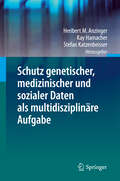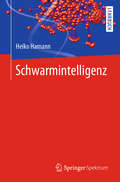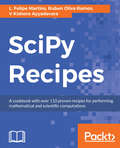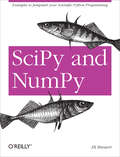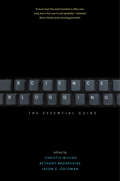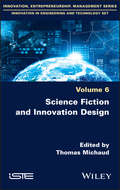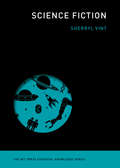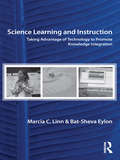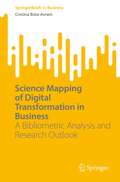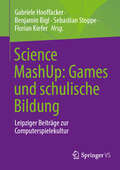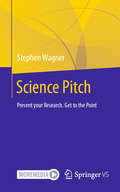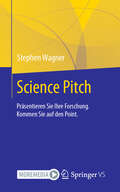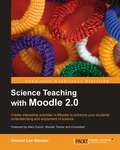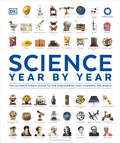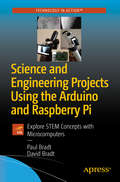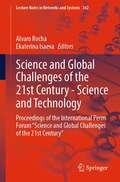- Table View
- List View
Schutz genetischer, medizinischer und sozialer Daten als multidisziplinäre Aufgabe
by Stefan Katzenbeisser Kay Hamacher Heribert M. AnzingerFortschritte in der Medizin, in der Genomforschung und in der Informationstechnik stellen den Datenschutz vor ein Dilemma: Forschung und die Anwendung neuer Methoden setzen häufig voraus, dass personenbezogene Daten in großem Umfang zentral verfügbar, verteilbar und verknüpfbar sind. Gleichzeitig bergen zentrale Datensammlungen und die unübersehbare Weitergabe und Verknüpfung sensitiver Daten die Gefahr, dass der Einzelne auf ein Datenraster reduziert wird und Selbstbestimmungsmöglichkeiten verliert. Den Wertungskonflikten und der Schutzbedürftigkeit und Schutzfähigkeit personenbezogener genetischer, medizinischer und sozialer Daten widmete sich eine multidisziplinäre Veranstaltungsreihe des Center for Advanced Security Research Darmstadt, der Darmstädter Juristischen Gesellschaft und der Fakultät für Rechts- und Wirtschaftswissenschaften der Technischen Universität Darmstadt. Der vorliegende Band fasst die dabei entwickelten Gedanken verschiedener Wissenschaftsdisziplinen zusammen.
Schwarmintelligenz
by Heiko HamannDieses Buch veranschaulicht mithilfe mathematischer Modelle, wie man die kollektive Intelligenz natürlicher Systeme untersucht und anschließend in intelligente Algorithmen und Roboterschwärme übersetzt. Menschen nutzen Tiere seit Jahrtausenden zur Unterstützung ihrer Arbeiten und dies wird sich auch in der Zukunft nicht ändern: Anstelle der lebenden Tiere werden es jedoch ihre Intelligenzleistungen und Kommunikationsstrategien sein, die unsere modernen Leben immer mehr beeinflussen. Heiko Hamann begeistert mit seiner Faszination für die Leistungen tierischer und menschlicher Gesellschaften. In einfachen Beispielen und in eleganter, präziser und einfach verständlicher Weise erklärt er diese Systeme und ihren Inspirationsursprung.
SciPy Recipes: A cookbook with over 110 proven recipes for performing mathematical and scientific computations
by Luiz Felipe Martins Ruben Oliva Ramos Kishore Ayyadevara Tomas Oliva Ke WuKey Features Covers a wide range of data science tasks using SciPy, NumPy, pandas, and matplotlibEffective recipes on advanced scientific computations, statistics, data wrangling, data visualization, and moreA must-have book if you're looking to solve your data-related problems using SciPy, on-the-goBook DescriptionWith the SciPy Stack, you get the power to effectively process, manipulate, and visualize your data using the popular Python language. Utilizing SciPy correctly can sometimes be a very tricky proposition. This book provides the right techniques so you can use SciPy to perform different data science tasks with ease.This book includes hands-on recipes for using the different components of the SciPy Stack such as NumPy, SciPy, matplotlib, and pandas, among others. You will use these libraries to solve real-world problems in linear algebra, numerical analysis, data visualization, and much more. The recipes included in the book will ensure you get a practical understanding not only of how a particular feature in SciPy Stack works, but also of its application to real-world problems. The independent nature of the recipes also ensure that you can pick up any one and learn about a particular feature of SciPy without reading through the other recipes, thus making the book a very handy and useful guide.What you will learn Get a solid foundation in scientific computing using Python Master common tasks related to SciPy and associated libraries such as NumPy, pandas, and matplotlib Perform mathematical operations such as linear algebra and work with the statistical and probability functions in SciPy Master advanced computing such as Discrete Fourier Transform and K-means with the SciPy Stack Implement data wrangling tasks efficiently using pandas Visualize your data through various graphs and charts using matplotlib
SciPy and NumPy: An Overview for Developers (Oreilly And Associate Ser.)
by Eli BressertAre you new to SciPy and NumPy? Do you want to learn it quickly and easily through examples and a concise introduction? Then this is the book for you. You’ll cut through the complexity of online documentation and discover how easily you can get up to speed with these Python libraries.Ideal for data analysts and scientists in any field, this overview shows you how to use NumPy for numerical processing, including array indexing, math operations, and loading and saving data. You’ll learn how SciPy helps you work with advanced mathematical functions such as optimization, interpolation, integration, clustering, statistics, and other tools that take scientific programming to a whole new level.The new edition is now available, fully revised and updated in June 2013.Learn the capabilities of NumPy arrays, element-by-element operations, and core mathematical operationsSolve minimization problems quickly with SciPy’s optimization packageUse SciPy functions for interpolation, from simple univariate to complex multivariate casesApply a variety of SciPy statistical tools such as distributions and functionsLearn SciPy’s spatial and cluster analysis classesSave operation time and memory usage with sparse matrices
Science
by Randy Bell Malcolm B. Butler Kathy Cabe TrundleTwenty American academics, researchers, and high school science teachers contribute nine chapters offering secondary science educators--from seasoned educators to those who are early in their career--suggestions on how to change their teaching methods to prepare students for life and work. Topics addressed include inquiry, implementing change strategies, the role of curriculum materials in reform, building leadership teams to create professional learning communities, building partnerships to support reform, using data from student assessments, and addressing the needs of linguistically diverse students . Annotation ©2009 Book News, Inc. , Portland, OR (booknews. com)
Science
by Randy Bell Malcolm B. Butler Kathy Cabe TrundleTwenty American academics, researchers, and high school science teachers contribute nine chapters offering secondary science educators--from seasoned educators to those who are early in their career--suggestions on how to change their teaching methods to prepare students for life and work. Topics addressed include inquiry, implementing change strategies, the role of curriculum materials in reform, building leadership teams to create professional learning communities, building partnerships to support reform, using data from student assessments, and addressing the needs of linguistically diverse students . Annotation ©2009 Book News, Inc. , Portland, OR (booknews. com)
Science
by Randy Bell Malcolm B. Butler Kathy Cabe TrundleNew computer-based technologies have revolutionized scientific research in recent years, yet computers remain curiously underutilised in many science classrooms. This engaging book shows you how to tap into the power of these new technologies to motivate students and support and enhance your existing curricula. Discover ways to use digital cameras, online databases and interactive simulation software to promote the kind of conceptual understanding and inquiry that drives real-world science. The 15 units on topics such as cell division, virtual dissection, earthquake modelling and the Doppler effect provide teachers with dozens of activities and lesson extensions in all of the major secondary school science areas. The units are introduced by essays that discuss project-based learning strategies, the creation of assessment rubrics and general guidelines for integrating technology in science instruction. Transform Your Science Classroom with Technology All units are keyed to the NETS. S Standards. Interdisciplinary links, teaching tips, lesson extenders and assessment guidelines are provided for each unit. Each unit includes a comprehensive listing of online and print resources for background reading and further exploration.
Science Blogging
by Bethany Brookshire Christie Wilcox Jason G. GoldmanHere is the essential how-to guide for communicating scientific research and discoveries online, ideal for journalists, researchers, and public information officers looking to reach a wide lay audience. Drawing on the cumulative experience of twenty-seven of the greatest minds in scientific communication, this invaluable handbook targets the specific questions and concerns of the scientific community, offering help in a wide range of digital areas, including blogging, creating podcasts, tweeting, and more. With step-by-step guidance and one-stop expertise, this is the book every scientist, science writer, and practitioner needs to approach the Wild West of the Web with knowledge and confidence.
Science Fiction Video Games
by Neal Roger TringhamUnderstand Video Games as Works of Science Fiction and Interactive Stories Science Fiction Video Games focuses on games that are part of the science fiction genre, rather than set in magical milieux or exaggerated versions of our own world. Unlike many existing books and websites that cover some of the same material, this book emphasizes critical a
Science Fiction and Innovation Design
by Thomas MichaudScience fiction is often presented as a source of utopia, or even of prophecies, used in capitalism to promote social, political and technoscientific innovations. Science Fiction and Innovation Design assesses the validity of this approach by exploring the impact this imaginary world has on the creativity of engineers and researchers. Companies seek to anticipate and predict the future through approaches such as design fiction: mobilizing representations of science fiction to create prototypes and develop scenarios relevant to organizational strategy. The conquest of Mars or the weapons of the future are examples developed by authors to demonstrate how design innovation involves continuous dialogue between multiple players, from the scientist to the manager, through to the designers and the science fiction writers.
Science Fiction: Science Fiction And The Question Of The Animal (The MIT Press Essential Knowledge series #39)
by Sherryl VintHow science fiction has been a tool for understanding and living through rapid technological change.The world today seems to be slipping into a science fiction future. We have phones that speak to us, cars that drive themselves, and connected devices that communicate with each other in languages we don't understand. Depending the news of the day, we inhabit either a technological utopia or Brave New World nightmare. This volume in the MIT Press Essential Knowledge surveys the uses of science fiction. It focuses on what is at the core of all definitions of science fiction: a vision of the world made otherwise and what possibilities might flow from such otherness.
Science Learning and Inquiry with Technology (Ed Psych Insights)
by Diane Jass Ketelhut Michael Shane TutwilerWhen implemented effectively, technology has great potential to positively connect with learning, assessment, and motivation in the context of K–12 science education and inquiry. Written by leading experts on technology-enhanced science learning and educational research, this book situates the topic within the broader context of educational psychology research and theory and brings it to a wider audience. With chapters on the fundamentals of science learning and assessment, integration of technology into classrooms, and examples of specific technologies, this concise volume is designed for any course on science learning that includes technology use in the curriculum. It will be indispensable for student researchers and both pre- and in-service teachers alike.
Science Learning and Instruction: Taking Advantage of Technology to Promote Knowledge Integration
by Bat-Sheva Eylon Marcia C. LinnScience Learning and Instruction describes advances in understanding the nature of science learning and their implications for the design of science instruction. The authors show how design patterns, design principles, and professional development opportunities coalesce to create and sustain effective instruction in each primary scientific domain: earth science, life science, and physical science. Calling for more in depth and less fleeting coverage of science topics in order to accomplish knowledge integration, the book highlights the importance of designing the instructional materials, the examples that are introduced in each scientific domain, and the professional development that accompanies these materials. It argues that unless all these efforts are made simultaneously, educators cannot hope to improve science learning outcomes. The book also addresses how many policies, including curriculum, standards, guidelines, and standardized tests, work against the goal of integrative understanding, and discusses opportunities to rethink science education policies based on research findings from instruction that emphasizes such understanding.
Science Mapping of Digital Transformation in Business: A Bibliometric Analysis and Research Outlook (SpringerBriefs in Business)
by Cristina Bota-AvramDigital transformation will affect every company or organization sooner or later, regardless of the industry, country, or type of organization. In recent years, this impact has become disruptive, and there is an increasing need for companies to innovate their business models while using various emerging technologies. The key goals of this book are twofold. The first goal is to provide a comprehensive overview of the state of digital transformation in business using various bibliometric indicators, while the second goal is to propose a synthesis of the potential directions and opportunities for future research agenda related to this field of research. The bibliometric analysis of the current state of knowledge published in the field of digital transformation in business over the last 20 years reveals the existence of four major thematic clusters: (1) the digital transformation process, (2) digital technologies, (3) the digital economy, and (4) digital disruption. Based on the content analysis of the most important articles that belonged to each cluster of topics, the book outlines several directions for future research. This makes it a useful resource for researchers interested in the field of digital transformation in business.
Science MashUp: Leipziger Beiträge zur Computerspielekultur
by Gabriele Hooffacker Florian Kiefer Benjamin Bigl Sebastian StoppeSpielen in der Schule? Spielen und schulische Bildung schlossen sich lange Zeit aus: Spiel fand in der Freizeit statt, Schule bereitete auf den Arbeitsprozess vor. Doch die Integration von digitalen Spielen in den schulischen Bildungsbereich hat in den letzten Jahren zunehmend an Bedeutung gewonnen. Der Band Science MashUp: Games und schulische Bildung versammelt die Beiträge zur gleichnamigen Tagung im April 2024 in Leipzig. Die Perspektiven von Lehrkräften, Eltern und Schülern stehen dabei im Fokus von drei Themenbereichen: 1. Standpunkte: Games in der Schule, 2. Best Practices: Games im Unterricht, 3. Spiele, Technik und Wissen: Digitale Bildungskultur im Wandel.
Science Pitch: Present your Research. Get to the Point
by Stephen WagnerHow can scientists present their projects with power to the point? This book is the ultimate guide for transforming complex research into captivating, convincing Science Pitches in a given time. The innovative ESPRIT model equips scientists with tools to blend professional expertise with personal passion, ensuring every presentation resonates deeply with its target audience. This concise manual combines research excellence and professionalism. It integrates artificial intelligence (AI) applications and slide design. Practice-oriented advice is enriched with real-world examples preparing for outstanding presentations. Designed for students and researchers eager to gain visibility, this book is a unique guide to getting your message across; it advances your research and engages your audience. Unlock your project’s potential and wrap expertise and passion in unique science storytelling. The Science Pitch results in a convincing short talk, successful networking, and securing funding approval for the research project. Via app: Download the SN More Media app for free, scan a link with play button and access videos directly on your smartphone or tablet.
Science Pitch: Präsentieren Sie Ihre Forschung. Kommen Sie auf den Point.
by Stephen WagnerWie können WissenschaftlerInnen ihre Projekte mit Power auf den Point präsentieren? Als ultimativer Leitfaden übersetzt dieses Buch komplexe Forschung in überzeugende Kurzvorträge. Das innovative ESPRIT-Modell gibt WissenschaftlerInnen die nötigen Tools an die Hand, um Professionalität mit Persönlichkeit zu verbinden und so ihr Zielpublikum zu überzeugen. Dieses Praxis-Handbuch integriert Anwendungen der Künstlichen Intelligenz (KI) und Foliengestaltung. Praxisorientierte Tipps mit konkreten Beispielen zeigen auf, wie Studierende und Forschende sichtbar als ExpertInnen wahrgenommen werden können. Mit diesem einzigartigen Leitfaden können sie prägnante Botschaften vermitteln sowie fachliche Expertise und persönliche Leidenschaft zu einem einzigartigen wissenschaftlichen Storytelling verbinden. Der Science Pitch ermöglicht überzeugende Kurzvorträge, erfolgreiches Networking und die Zusage von Fördermitteln für Forschungsprojekte.
Science Teaching with Moodle 2.0
by Vincent Lee StockerPacked with lots of practical examples, each chapter takes you through a different aspect of teaching using Moodle. All examples are based around a sample science course, which you can see growing throughout the book.This book is for science teachers who would like to enhance their lessons using Moodle. It doesn't matter if you haven't used Moodle before; as long as someone has set it up for you, you can get started with the exercises in the book straightaway.
Science Videos: A User's Manual For Scientific Communication
by Ryan VachonEffective science communication is no easy task. While the effective conveyance of technical knowledge presents formidable roadblocks to sharing scientific knowledge and discoveries, certain communication tools like video and film production help to bridge this gap. This user’s manual provides a complete set of easy-to-follow directions for video-making as well as tricks of the trade to leverage these skills to better inform the intended audience.
Science Year by Year: The Ultimate Visual Guide to the Discoveries that Changed the World (DK Definitive Visual Histories)
by DKThis epic journey of scientific discovery starts in ancient times and travels through centuries of invention before fast forwarding into the future. From simple machines to modern-day marvels, you’ll follow incredible illustrated timelines that plot the entire history of science and highlight the most momentous discoveries. A jaw-dropping collection of more than 1,500 photographs, illustrations, maps, and graphics charts the evolution of science year by year, century by century.?? You’ll meet influential inventors and famous faces from the past, including Aristotle, Leonardo da Vinci, Isaac Newton, Charles Darwin, Marie Curie, and Stephen Hawking. You’ll visit places of scientific importance, such as prehistoric cave art, Stonehenge, Hiroshima and the first atomic bomb, the Moon landings, and the Higgs boson particle. These huge events are made simple thanks to eye-catching images, helpful timelines, and accessible, informative text.?? Landmark people and periods are combined in this one stunning volume for children, showcasing the ideas, experiments, and technologies that have shaped our daily lives and transformed the world today.?? Aspiring scientists, get ready for a time traveling trip like no other.
Science and Engineering Projects Using the Arduino and Raspberry Pi: Explore STEM Concepts with Microcomputers
by Paul Bradt David BradtHone your understanding of science and engineering concepts with the versatile Arduino microcontroller and powerful Raspberry Pi mini-computer. The simple, straightforward, fun projects in this book use the Arduino and Raspberry Pi to build systems that explore key scientific concepts and develop engineering skills. Areas explored include force/acceleration, heat transfer, light, and astronomy. You'll work with advanced tools, such as data logging, advanced design, manufacturing, and assembly techniques that will take you beyond practical application of the projects you'll be creating. Technology is ever evolving and changing. This book goes beyond simple how-tos to teach you the concepts behind these projects and sciences. You'll gain the skills to observe and adapt to changes in technology as you work through fun and easy projects that explore fundamental concepts of engineering and science. What You'll LearnMeasure the acceleration of a car you're riding inSimulate zero gravityCalculate the heat transfer in and out of your housePhotography the moon and planetsWho This Book Is ForHobbyists, students, and instructors interested in practical applications and methods to measure and learn about the physical world using inexpensive Maker technologies.
Science and Global Challenges of the 21st Century - Science and Technology: Proceedings of the International Perm Forum “Science and Global Challenges of the 21st Century” (Lecture Notes in Networks and Systems #342)
by Alvaro Rocha Ekaterina IsaevaThis book comprises the proceedings of the International Perm Forum “Science and Global Challenges of the 21st Century” held on October 18th – 23rd, 2021, at Perm State University, Perm, Russia. Global challenges, which determine the main trends in the development of social and economic life in the XXI century, require the integration of specialists in various fields of knowledge. That is why the main principle of this edition is interdisciplinarity, the formation of end-to-end innovation chains, including fundamental and applied research, and the wide application of smart innovations, networks, and information technologies. The authors seek to find synergy between technologies and such fields as computer science, geosciences, biology, linguistics, social studies, historical studies, and economics. The book is of interest to researchers seeking nontrivial solutions at the interface of sciences, digital humanities, computational linguistics, cognitive studies, machine learning, and others.
Science and Global Challenges of the 21st Century – Innovations and Technologies in Interdisciplinary Applications (Lecture Notes in Networks and Systems #622)
by Álvaro Rocha Ekaterina IsaevaThis book comprises proceedings of the 2022 International Forum “Science and Global Challenges of the XXI Century”. The main principle of the Forum’s program is interdisciplinarity, the formation of end-to-end innovation chains: fundamental and applied research, technology development, implementation, and wide application of networks and systems. In 2022, the central theme of the forum is innovations and technologies in interdisciplinary applications. The book covers a wide range of knowledge-communication methodologies and effective technologies for processing data in various forms and areas. The book might interest researchers working at the interface of disciplines, such as e-learning, digital humanities, computational linguistics, cognitive studies, GIS, digital geography, machine learning, and others. It can also be a valuable source of information for Bachelor and Master students with open curricula or majors and minors who seek to find a balance between several fields of their interest.
Science and Technologies for Smart Cities: 5th EAI International Summit, SmartCity360, Braga, Portugal, December 4-6, 2019, Proceedings (Lecture Notes of the Institute for Computer Sciences, Social Informatics and Telecommunications Engineering #323)
by Henrique Santos Gabriela Viale Pereira Matthias Budde Sérgio F. Lopes Predrag NikolicThis book constitutes the refereed proceedings of the 5th Annual Smart City 360° Summit, held in Braga, Portugal, in December 2019. The volume combines selected papers of four conferences, namely IoT in Urban Space, Urb-IoT 2019, Smart Governance for Sustainable Smart Cities, SmartGov 2019, Sensor Systems and Software, S-Cube 2019, and Intelligent Technologies for Interactive Entertainment, Intetain 2019. The 5 keynote and 32 conference papers presented were carefully reviewed and selected from 113 submissions and present results of multidisciplinary scientific and industry collaboration to solve complex societal, technological and economic problems Smart Cities. As such, the main goals are to promote quality of life, work conditions, mobility and sustainability.
Science and Technologies for Smart Cities: 6th EAI International Conference, SmartCity360°, Virtual Event, December 2-4, 2020, Proceedings (Lecture Notes of the Institute for Computer Sciences, Social Informatics and Telecommunications Engineering #372)
by Nishu Gupta Sara Paiva Rafik Zitouni Sérgio F. Lopes Sérgio Ivan Lopes Takuro YonezawaThis book constitutes the refereed proceedings of the 6th Annual Smart City 360° Summit. Due to COVID-19 pandemic the conference was held virtually. The volume combines selected papers of seven conferences, namely AISCOVID 2020 - International Conference on AI-assisted Solutions for COVID-19 and Biomedical Applications in Smart-Cities; EdgeIoT 2020 - International Conference on Intelligent Edge Processing in the IoT Era; IC4S 2020 - International Conference on Cognitive Computing and Cyber Physical Systems; CiCom 2020 - International Conference on Computational Intelligence and Communications; S-Cube 2020 - International Conference on Sensor Systems and Software; SmartGov 2020 - International Conference on Smart Governance for Sustainable Smart Cities; and finnally, the Urb-IOT 2020 -International Conference on IoT in Urban Space.
